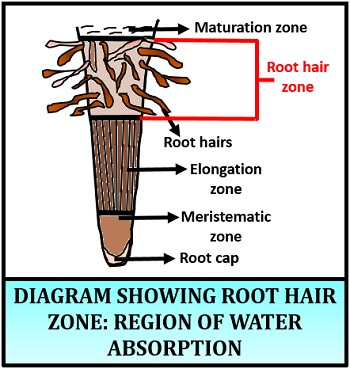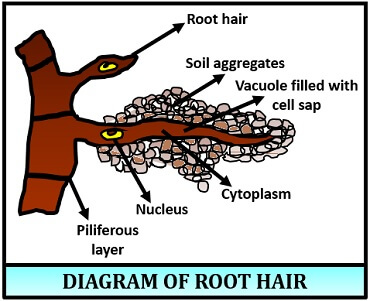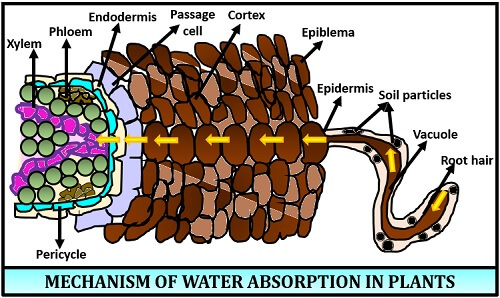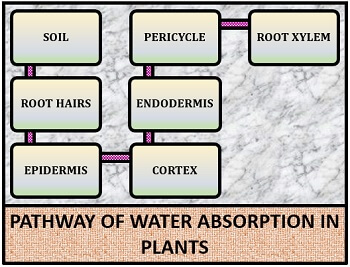Absorption of water in plants is a vital process that is important for plant growth and other metabolic activities. Water absorption in lower plants takes place by the process of osmosis through the whole plant body. In higher plants, the mechanism of water absorption is through the root hairs.
Plants mainly absorb water from the soil by the capillary action. There are five types of water that are found in the soil, namely runway water, gravitational water, hygroscopic water, chemically combined water and capillary water. Among the runaway water, gravitational water, hygroscopic water, chemically combined water, only the capillary water is useful for the plant.
There are some epiphytic plants, which grow on the substratum like rock and soil, while other plants absorb water by their aerial roots. The total water content in the soil is called holard. The water content consumed by the plant is called chesord. Water unconsumed by the plant is called echard.
Content: Absorption of Water In Plants
- Definition
- History
- Types of water absorption in plants
- Role of root hairs in water absorption
- Mechanism of water absorption in plants
- Factors affecting water absorption in plants
- Conclusion
Definition
Absorption of water in plants is a biological process, in which the plants uptake capillary water from the soil to the root xylem through the root hairs during various plant processes like respiration, transpiration and osmosis. The water supply is an important factor, which directly or indirectly influences all the plant activities such as photosynthesis, internal water balance etc.
Loss of water in plants may result in loss or turgor, leaf-wilting, closure of stomata, reduction in photosynthetic activity and protoplasm disorganization. In plants, the absorbed water typically exists in two phases, namely apoplastic and symplastic water. Apoplastic water resides with the cell wall and xylem components, whereas symplastic water remains in the cell protoplast.
History
- Firstly, the two types (active and passive water absorption) were introduced by the scientist named Renner in 1912-1915.
- After the types of water absorption, two theories were introduced to know more about the concept of active absorption of water.
- The osmotic theory was given by the two scientists Atxins and Priestley.
- The non-osmotic theory was given by Bennet, Clark and Thimann in 1951.
Types of Water Absorption in Plants
Plants typically absorb water by the following two methods:
- Active absorption of water
- Passive absorption of water
Active Absorption of Water
This type of water absorption requires the expenditure of metabolic energy by the root cells to perform the metabolic activity like respiration. Active absorption in plant occurs in two ways, namely osmotic and non-osmotic absorption of water.
- Osmotic active absorption of water: In this type, the water absorption occurs through osmosis where the water moves into the root xylem across the concentration gradient of the root cell. The osmotic movement is due to the high concentration of solute in the cell sap and low concentration of the surrounding soil.
- Non-osmotic active absorption of water: Here, the water absorption occurs where the water enters the cell from the soil against the concentration gradient of the cell. This requires the expenditure of metabolic energy through the respiration process. Hence, as the rate of respiration increases, the rate of water absorption will also increase. Auxin is a growth regulatory hormone, which increases the rate of respiration in plants that, in turn, also increase the rate of water absorption.
Passive Absorption of Water
This type of water absorption does not require the use of metabolic energy. The absorption occurs by metabolic activity like transpiration. Passive absorption is the type where the water absorption is through the transpiration pull. This creates tension or force that helps in the movement of water upwards into the xylem sap. Higher is the transpiration rate, and higher is the absorption of water.
Role of Root Hairs in Water Absorption
A root contains some tubular, hair-like and unicellular structures called Root hairs. In the root system, the region from which the root hairs protrude out is termed as Root hair zone. The zone of root hair is the only region that participates in water absorption activity. Root hair zone is the water-permeable region. Root hairs are the outgrowths, which arise from the epidermal layer called the piliferous layer.

The cell wall of root hair consists of a double layer membrane. Pectin is present in the outer layer, and cellulose is present in the cell wall’s inner layer. Under the cell wall, there is a selectively permeable cytoplasmic-membrane. The cell or cytoplasmic membrane will allow specific substances to pass across the cell concentration gradient.

Root cells, nucleus, and vacuole or cell sap are present inside the cytoplasmic membrane. Soil aggregates contain small droplets of water carried away by the root hairs into the root xylem through different mechanisms, out of which osmosis is most common.
Mechanism of Water Absorption in Plants
The movement of water from the soil to the root xylem occurs through the following stages:

- In the first step, the root hairs of the plant will absorb the water from the surrounding soil through the process of osmosis. The soil has high water concentration than the cell sap. Therefore, the water will move from a high concentration to the low concentration following osmosis through the cytoplasmic membrane of the root hairs.
- After entering into the root hair, the water will cross the epidermis or piliferous layer of the root system.
- Then, the water will move from the epidermis to the root cortex.
- From the root cortex, the water will travel through the endodermis that consists of suberic and passive cells. The further movement of water is facilitated by the passive cells.
- Then, water moves from the pericycle to the root xylem, i.e. perixylem and metaxylem. Water will be stored in the xylem root system, which can be utilized by the plant body to perform various metabolic activities and for its growth.

Factors Affecting
There are two kinds of factors that directly or indirectly influence the activity of water absorption.
Extrinsic factors: It includes external factors or environmental factors like:
- Soil water: Soil carries five different types of water, out of which the capillary water is useful for the biological activity of the plant.
- The concentration of soil solution: The concentration of soil must be less. If there is a high concentration of soil, then it will be called physiologically dry soil. Highly concentrated or dry soil makes the water absorption difficult.
- Soil air: There should be space between the soil particles for the proper air supply. If the quantity of oxygen is less, then the quantity of carbon dioxide will be more, which leads to the anaerobic respiration.
- Soil temperature: The optimum temperature is 20- 35 degrees Celsius.
Intrinsic factors: It involves the metabolic activities like respiration, transcription and the number of root hairs which directly influences the rate of water absorption.
Conclusion
Therefore, water absorption in plants occurs through the root hairs that carry the water present in the soil and forms a zone called the root hair zone. The root hairs absorb water through their wall, which is water-loving “Hydrophilic” in nature. Therefore, the high permeability of root hairs to the water will help in uptake water either through osmosis or transpiration.
Ur answer is quite good 👏….
Amazing!